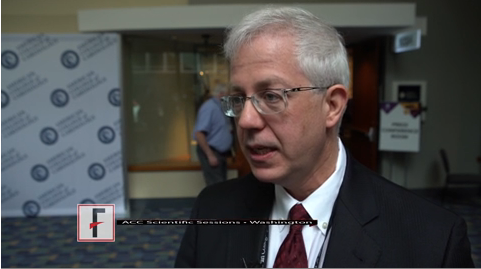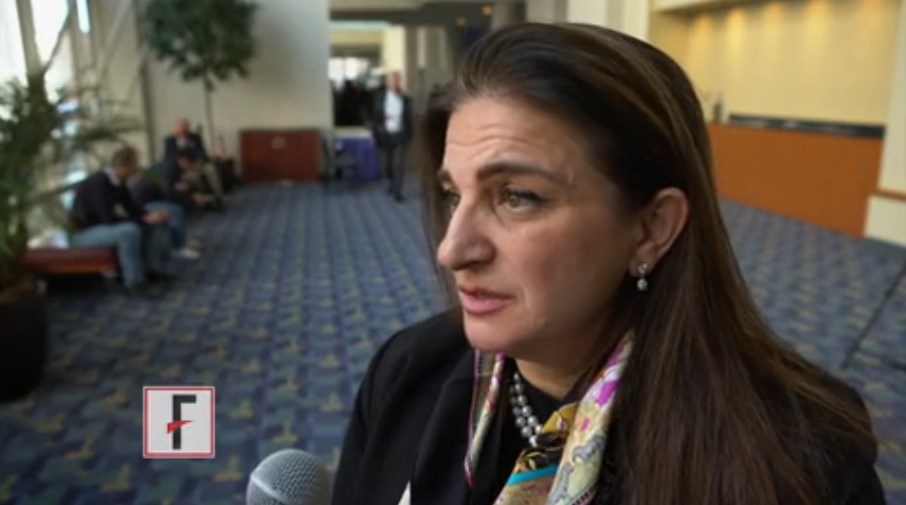User login
VIDEO: iFR outperforms FFR in two major trials
WASHINGTON – Instantaneous wave-free ratio (iFR) is the new evidence-based standard of care for invasive physiologic assessment of stable coronary lesions of intermediate angiographic severity, supplanting the older fractional flow reserve (FFR) technology, Matthias Gotberg, MD, said at the annual meeting of the American College of Cardiology.
The virtually identical results of these two trials should encourage more interventional cardiologists to incorporate physiologic assessment of stable coronary lesions into their clinical practice instead of relying solely on anatomic assessment by angiography, which abundant evidence shows is insufficiently accurate in identifying hemodynamically significant lesions warranting revascularization.
FFR never really caught on because of its limitations. DEFINE-FLAIR and iFR-SWEDEHEART show that iFR overcomes those limitations, said Dr. Gotberg, director of the cardiac catheterization laboratory at Skane University Hospital in Lund, Sweden.
The two studies showed that iFR was noninferior to FFR in the 1-year composite endpoint of all-cause mortality, nonfatal MI, or unplanned revascularization. And iFR was associated with significantly shorter procedure times, less stent utilization, and markedly less patient discomfort because, unlike FFR, it doesn’t require administration of adenosine to induce hyperemia.
Indeed, in iFR-SWEDEHEART, which included more than 2,000 randomized patients in three Scandinavian countries, only 3% of the iFR group reported experiencing chest pain, dyspnea, or other forms of discomfort during their procedure, compared with 68% of the FFR group, Dr. Gotberg explains in this video interview.[[{"fid":"192539","view_mode":"medstat_image_full_text","attributes":{"height":"390","width":"100%","class":"media-element file-medstat-image-full-text","data-delta":"1"},"fields":{"format":"medstat_image_full_text"},"type":"media","field_deltas":{"1":{"format":"medstat_image_full_text"}}}]]
WASHINGTON – Instantaneous wave-free ratio (iFR) is the new evidence-based standard of care for invasive physiologic assessment of stable coronary lesions of intermediate angiographic severity, supplanting the older fractional flow reserve (FFR) technology, Matthias Gotberg, MD, said at the annual meeting of the American College of Cardiology.
The virtually identical results of these two trials should encourage more interventional cardiologists to incorporate physiologic assessment of stable coronary lesions into their clinical practice instead of relying solely on anatomic assessment by angiography, which abundant evidence shows is insufficiently accurate in identifying hemodynamically significant lesions warranting revascularization.
FFR never really caught on because of its limitations. DEFINE-FLAIR and iFR-SWEDEHEART show that iFR overcomes those limitations, said Dr. Gotberg, director of the cardiac catheterization laboratory at Skane University Hospital in Lund, Sweden.
The two studies showed that iFR was noninferior to FFR in the 1-year composite endpoint of all-cause mortality, nonfatal MI, or unplanned revascularization. And iFR was associated with significantly shorter procedure times, less stent utilization, and markedly less patient discomfort because, unlike FFR, it doesn’t require administration of adenosine to induce hyperemia.
Indeed, in iFR-SWEDEHEART, which included more than 2,000 randomized patients in three Scandinavian countries, only 3% of the iFR group reported experiencing chest pain, dyspnea, or other forms of discomfort during their procedure, compared with 68% of the FFR group, Dr. Gotberg explains in this video interview.[[{"fid":"192539","view_mode":"medstat_image_full_text","attributes":{"height":"390","width":"100%","class":"media-element file-medstat-image-full-text","data-delta":"1"},"fields":{"format":"medstat_image_full_text"},"type":"media","field_deltas":{"1":{"format":"medstat_image_full_text"}}}]]
WASHINGTON – Instantaneous wave-free ratio (iFR) is the new evidence-based standard of care for invasive physiologic assessment of stable coronary lesions of intermediate angiographic severity, supplanting the older fractional flow reserve (FFR) technology, Matthias Gotberg, MD, said at the annual meeting of the American College of Cardiology.
The virtually identical results of these two trials should encourage more interventional cardiologists to incorporate physiologic assessment of stable coronary lesions into their clinical practice instead of relying solely on anatomic assessment by angiography, which abundant evidence shows is insufficiently accurate in identifying hemodynamically significant lesions warranting revascularization.
FFR never really caught on because of its limitations. DEFINE-FLAIR and iFR-SWEDEHEART show that iFR overcomes those limitations, said Dr. Gotberg, director of the cardiac catheterization laboratory at Skane University Hospital in Lund, Sweden.
The two studies showed that iFR was noninferior to FFR in the 1-year composite endpoint of all-cause mortality, nonfatal MI, or unplanned revascularization. And iFR was associated with significantly shorter procedure times, less stent utilization, and markedly less patient discomfort because, unlike FFR, it doesn’t require administration of adenosine to induce hyperemia.
Indeed, in iFR-SWEDEHEART, which included more than 2,000 randomized patients in three Scandinavian countries, only 3% of the iFR group reported experiencing chest pain, dyspnea, or other forms of discomfort during their procedure, compared with 68% of the FFR group, Dr. Gotberg explains in this video interview.[[{"fid":"192539","view_mode":"medstat_image_full_text","attributes":{"height":"390","width":"100%","class":"media-element file-medstat-image-full-text","data-delta":"1"},"fields":{"format":"medstat_image_full_text"},"type":"media","field_deltas":{"1":{"format":"medstat_image_full_text"}}}]]
AT ACC 17
VIDEO: Evolocumab caused no cognitive issues in FOURIER substudy
WASHINGTON – Don’t give the cognitive effects of evolocumab a second thought, results from a preplanned substudy of the landmark FOURIER study that assessed the impact of this PCSK9 inhibitor on memory or other measures of cognition in a random subgroup of 1,973 patients enrolled in the main study suggest.
Based on these results “I wouldn’t be concerned about adverse cognitive effects” in patients treated with evolocumab (Repatha) or, for the time being, any other PCSK9 inhibitor, said Robert P. Giugliano, MD, in a video interview at the annual meeting of the American College of Cardiology”
Concerns about the cognitive effects of the drugs in this class of lipid-lowering drugs have lingered following suggestions of a possible problem that arose during earlier, much smaller studies of these agents as well as similar concerns that arose about statins that have been perpetuated through misleading posts on the Internet.
The battery of memory and cognition assessments used in EBBINGHAUS, the FOURIER substudy, should lay concerns about brain effects of evolocumab to rest, at least within the context of the median 26 months of treatment that patients in FOURIER received, said Dr. Giugliano, a cardiologist at Brigham and Women’s Hospital in Boston and lead investigator of the EBBINGHAUS substudy. Further analysis also showed that, even among patients who achieved LDL cholesterol levels of less than 25 mg/dL, treatment with evolocumab appeared to cause no deterioration of the measured mental functions.
The video associated with this article is no longer available on this site. Please view all of our videos on the MDedge YouTube channel
mzoler@frontlinemedcom.com
On Twitter @mitchelzoler
WASHINGTON – Don’t give the cognitive effects of evolocumab a second thought, results from a preplanned substudy of the landmark FOURIER study that assessed the impact of this PCSK9 inhibitor on memory or other measures of cognition in a random subgroup of 1,973 patients enrolled in the main study suggest.
Based on these results “I wouldn’t be concerned about adverse cognitive effects” in patients treated with evolocumab (Repatha) or, for the time being, any other PCSK9 inhibitor, said Robert P. Giugliano, MD, in a video interview at the annual meeting of the American College of Cardiology”
Concerns about the cognitive effects of the drugs in this class of lipid-lowering drugs have lingered following suggestions of a possible problem that arose during earlier, much smaller studies of these agents as well as similar concerns that arose about statins that have been perpetuated through misleading posts on the Internet.
The battery of memory and cognition assessments used in EBBINGHAUS, the FOURIER substudy, should lay concerns about brain effects of evolocumab to rest, at least within the context of the median 26 months of treatment that patients in FOURIER received, said Dr. Giugliano, a cardiologist at Brigham and Women’s Hospital in Boston and lead investigator of the EBBINGHAUS substudy. Further analysis also showed that, even among patients who achieved LDL cholesterol levels of less than 25 mg/dL, treatment with evolocumab appeared to cause no deterioration of the measured mental functions.
The video associated with this article is no longer available on this site. Please view all of our videos on the MDedge YouTube channel
mzoler@frontlinemedcom.com
On Twitter @mitchelzoler
WASHINGTON – Don’t give the cognitive effects of evolocumab a second thought, results from a preplanned substudy of the landmark FOURIER study that assessed the impact of this PCSK9 inhibitor on memory or other measures of cognition in a random subgroup of 1,973 patients enrolled in the main study suggest.
Based on these results “I wouldn’t be concerned about adverse cognitive effects” in patients treated with evolocumab (Repatha) or, for the time being, any other PCSK9 inhibitor, said Robert P. Giugliano, MD, in a video interview at the annual meeting of the American College of Cardiology”
Concerns about the cognitive effects of the drugs in this class of lipid-lowering drugs have lingered following suggestions of a possible problem that arose during earlier, much smaller studies of these agents as well as similar concerns that arose about statins that have been perpetuated through misleading posts on the Internet.
The battery of memory and cognition assessments used in EBBINGHAUS, the FOURIER substudy, should lay concerns about brain effects of evolocumab to rest, at least within the context of the median 26 months of treatment that patients in FOURIER received, said Dr. Giugliano, a cardiologist at Brigham and Women’s Hospital in Boston and lead investigator of the EBBINGHAUS substudy. Further analysis also showed that, even among patients who achieved LDL cholesterol levels of less than 25 mg/dL, treatment with evolocumab appeared to cause no deterioration of the measured mental functions.
The video associated with this article is no longer available on this site. Please view all of our videos on the MDedge YouTube channel
mzoler@frontlinemedcom.com
On Twitter @mitchelzoler
AT ACC 2017
VIDEO: Clear food labels may improve healthy habits
WASHINGTON – Application clear graphic nutrition labels on the front of packaged foods could help patients make healthier food choices, according to a study out of the George Institute of Global Health, Sydney.
Bruce Neal, PhD, senior director of the food policy division at the institute, and his colleagues asked 1,578 study participants to use a smart phone scanner to record the packaged foods they bought over the course of a week. Nutrition information from those scans was used to derive a nutrient profile score and plugged into four different food labeling systems on a randomized basis:
- Health Star Rating (HSR). A graphic label that gives the product from one to five stars.
- Multi-color Traffic Light (MTD). A graphic label that advises the participant to stop, use caution, or go.
- Daily Intake Guide (DIG). A graphic label that presents important nutrients in larger numbers.
- Nutrient Information Panel (NIP). A chart-based label listing nutrient values, similar to the U.S. Nutrition Facts label.
Nutrient information provided by HSR was found to be noninferior to the alternatives, Dr. Neal said at the annual meeting of the American College of Cardiology.
HSR earned a superiority score of 0.38, 0.1, and 0.23 when compared with MTL, DIG, and NIP labels, respectively, according to the study.
The video associated with this article is no longer available on this site. Please view all of our videos on the MDedge YouTube channel
Dr. Neal attributed the “unimpressive results” in part to the use of the smart phone interface.
“The trial used a smart phone design, which is a suboptimal surrogate, compared with printed on every pack. In the real world it would work better,” he said in a video interview.
While overall mean nutrition information was found to be not inferior, HSR scored significantly higher that the alternatives in user perception. In understandability, HSR scored 0.62 (P = .005), 1.02 (P less than .001), and 0.22 (P equal .32), compared with MTL, DIG, and NIP, respectively.
HSR also scored significantly higher among participants in “value of having on all food packs,” especially against DIG, scoring 0.70 (P = .002).
“It is absolutely clear that Health Star Rating is preferred to any of the other formats by consumers,” Dr. Neal said. “It is probably [also] fair to say Health Star is now the Australian government’s strongest choice.”
Participants were on average 38 years old, overwhelmingly female (84%), and well educated with 72% reporting a tertiary education or higher. Despite this more affluent and educated population, Dr. Neal and his colleagues believe that HSR can be used with any group.
“We are embarking on a project to roll out this smart phone application with a different interface suited to other, disadvantaged groups,” Dr. Neal said. “We are also working with the [Australian] state government to use Health Star for fast food restaurants and school canteens, as well as government procurement for use in hospitals and prisons.”
The study was limited by its reliance on participants to record their own purchases, Dr. Neal added.
ezimmerman@frontlinemedcom.com
On Twitter @EAZtweets
WASHINGTON – Application clear graphic nutrition labels on the front of packaged foods could help patients make healthier food choices, according to a study out of the George Institute of Global Health, Sydney.
Bruce Neal, PhD, senior director of the food policy division at the institute, and his colleagues asked 1,578 study participants to use a smart phone scanner to record the packaged foods they bought over the course of a week. Nutrition information from those scans was used to derive a nutrient profile score and plugged into four different food labeling systems on a randomized basis:
- Health Star Rating (HSR). A graphic label that gives the product from one to five stars.
- Multi-color Traffic Light (MTD). A graphic label that advises the participant to stop, use caution, or go.
- Daily Intake Guide (DIG). A graphic label that presents important nutrients in larger numbers.
- Nutrient Information Panel (NIP). A chart-based label listing nutrient values, similar to the U.S. Nutrition Facts label.
Nutrient information provided by HSR was found to be noninferior to the alternatives, Dr. Neal said at the annual meeting of the American College of Cardiology.
HSR earned a superiority score of 0.38, 0.1, and 0.23 when compared with MTL, DIG, and NIP labels, respectively, according to the study.
The video associated with this article is no longer available on this site. Please view all of our videos on the MDedge YouTube channel
Dr. Neal attributed the “unimpressive results” in part to the use of the smart phone interface.
“The trial used a smart phone design, which is a suboptimal surrogate, compared with printed on every pack. In the real world it would work better,” he said in a video interview.
While overall mean nutrition information was found to be not inferior, HSR scored significantly higher that the alternatives in user perception. In understandability, HSR scored 0.62 (P = .005), 1.02 (P less than .001), and 0.22 (P equal .32), compared with MTL, DIG, and NIP, respectively.
HSR also scored significantly higher among participants in “value of having on all food packs,” especially against DIG, scoring 0.70 (P = .002).
“It is absolutely clear that Health Star Rating is preferred to any of the other formats by consumers,” Dr. Neal said. “It is probably [also] fair to say Health Star is now the Australian government’s strongest choice.”
Participants were on average 38 years old, overwhelmingly female (84%), and well educated with 72% reporting a tertiary education or higher. Despite this more affluent and educated population, Dr. Neal and his colleagues believe that HSR can be used with any group.
“We are embarking on a project to roll out this smart phone application with a different interface suited to other, disadvantaged groups,” Dr. Neal said. “We are also working with the [Australian] state government to use Health Star for fast food restaurants and school canteens, as well as government procurement for use in hospitals and prisons.”
The study was limited by its reliance on participants to record their own purchases, Dr. Neal added.
ezimmerman@frontlinemedcom.com
On Twitter @EAZtweets
WASHINGTON – Application clear graphic nutrition labels on the front of packaged foods could help patients make healthier food choices, according to a study out of the George Institute of Global Health, Sydney.
Bruce Neal, PhD, senior director of the food policy division at the institute, and his colleagues asked 1,578 study participants to use a smart phone scanner to record the packaged foods they bought over the course of a week. Nutrition information from those scans was used to derive a nutrient profile score and plugged into four different food labeling systems on a randomized basis:
- Health Star Rating (HSR). A graphic label that gives the product from one to five stars.
- Multi-color Traffic Light (MTD). A graphic label that advises the participant to stop, use caution, or go.
- Daily Intake Guide (DIG). A graphic label that presents important nutrients in larger numbers.
- Nutrient Information Panel (NIP). A chart-based label listing nutrient values, similar to the U.S. Nutrition Facts label.
Nutrient information provided by HSR was found to be noninferior to the alternatives, Dr. Neal said at the annual meeting of the American College of Cardiology.
HSR earned a superiority score of 0.38, 0.1, and 0.23 when compared with MTL, DIG, and NIP labels, respectively, according to the study.
The video associated with this article is no longer available on this site. Please view all of our videos on the MDedge YouTube channel
Dr. Neal attributed the “unimpressive results” in part to the use of the smart phone interface.
“The trial used a smart phone design, which is a suboptimal surrogate, compared with printed on every pack. In the real world it would work better,” he said in a video interview.
While overall mean nutrition information was found to be not inferior, HSR scored significantly higher that the alternatives in user perception. In understandability, HSR scored 0.62 (P = .005), 1.02 (P less than .001), and 0.22 (P equal .32), compared with MTL, DIG, and NIP, respectively.
HSR also scored significantly higher among participants in “value of having on all food packs,” especially against DIG, scoring 0.70 (P = .002).
“It is absolutely clear that Health Star Rating is preferred to any of the other formats by consumers,” Dr. Neal said. “It is probably [also] fair to say Health Star is now the Australian government’s strongest choice.”
Participants were on average 38 years old, overwhelmingly female (84%), and well educated with 72% reporting a tertiary education or higher. Despite this more affluent and educated population, Dr. Neal and his colleagues believe that HSR can be used with any group.
“We are embarking on a project to roll out this smart phone application with a different interface suited to other, disadvantaged groups,” Dr. Neal said. “We are also working with the [Australian] state government to use Health Star for fast food restaurants and school canteens, as well as government procurement for use in hospitals and prisons.”
The study was limited by its reliance on participants to record their own purchases, Dr. Neal added.
ezimmerman@frontlinemedcom.com
On Twitter @EAZtweets
AT ACC 17
VIDEO: SURTAVI results ‘tremendously important’ for decision making
Washington – Heart teams will have more options when making treatment decisions for patients with severe aortic stenosis who are at intermediate risk, now that the results of the SURTAVI (Surgical Replacement and Transcatheter Aortic Valve Implantation) trial have been presented.
Those results showed that transcatheter aortic valve replacement (TAVR) in patients with severe aortic stenosis at intermediate risk was not only noninferior to surgical replacement, “but in my mind superior, because you don’t get your chest cracked, you get home earlier, and you have fewer strokes [in this trial], Roxana Mehran, MD, professor and director of interventional cardiovascular research at Mount Sinai Hospital in New York, said in a video interview at the annual meeting of the American College of Cardiology.
In SURTAVI, which used Medtronic’s self-expanding CoreValve and Evolut-R bioprostheses in 863 patients randomized to TAVR, 12.6% met the study’s primary endpoint – death from any cause or disabling stroke at 24 months – versus 14% of the 796 patients randomized to surgery, a statistically nonsignificant difference. Notably, the risk of any type of stroke at 30 days was statistically superior for TAVR, 3.4%, compared with 5.6% for surgical replacement.
“It’s tremendously important to see the change in how we’re going to be evaluating patients with aortic stenosis,” Dr. Mehran said.
The video associated with this article is no longer available on this site. Please view all of our videos on the MDedge YouTube channel
Washington – Heart teams will have more options when making treatment decisions for patients with severe aortic stenosis who are at intermediate risk, now that the results of the SURTAVI (Surgical Replacement and Transcatheter Aortic Valve Implantation) trial have been presented.
Those results showed that transcatheter aortic valve replacement (TAVR) in patients with severe aortic stenosis at intermediate risk was not only noninferior to surgical replacement, “but in my mind superior, because you don’t get your chest cracked, you get home earlier, and you have fewer strokes [in this trial], Roxana Mehran, MD, professor and director of interventional cardiovascular research at Mount Sinai Hospital in New York, said in a video interview at the annual meeting of the American College of Cardiology.
In SURTAVI, which used Medtronic’s self-expanding CoreValve and Evolut-R bioprostheses in 863 patients randomized to TAVR, 12.6% met the study’s primary endpoint – death from any cause or disabling stroke at 24 months – versus 14% of the 796 patients randomized to surgery, a statistically nonsignificant difference. Notably, the risk of any type of stroke at 30 days was statistically superior for TAVR, 3.4%, compared with 5.6% for surgical replacement.
“It’s tremendously important to see the change in how we’re going to be evaluating patients with aortic stenosis,” Dr. Mehran said.
The video associated with this article is no longer available on this site. Please view all of our videos on the MDedge YouTube channel
Washington – Heart teams will have more options when making treatment decisions for patients with severe aortic stenosis who are at intermediate risk, now that the results of the SURTAVI (Surgical Replacement and Transcatheter Aortic Valve Implantation) trial have been presented.
Those results showed that transcatheter aortic valve replacement (TAVR) in patients with severe aortic stenosis at intermediate risk was not only noninferior to surgical replacement, “but in my mind superior, because you don’t get your chest cracked, you get home earlier, and you have fewer strokes [in this trial], Roxana Mehran, MD, professor and director of interventional cardiovascular research at Mount Sinai Hospital in New York, said in a video interview at the annual meeting of the American College of Cardiology.
In SURTAVI, which used Medtronic’s self-expanding CoreValve and Evolut-R bioprostheses in 863 patients randomized to TAVR, 12.6% met the study’s primary endpoint – death from any cause or disabling stroke at 24 months – versus 14% of the 796 patients randomized to surgery, a statistically nonsignificant difference. Notably, the risk of any type of stroke at 30 days was statistically superior for TAVR, 3.4%, compared with 5.6% for surgical replacement.
“It’s tremendously important to see the change in how we’re going to be evaluating patients with aortic stenosis,” Dr. Mehran said.
The video associated with this article is no longer available on this site. Please view all of our videos on the MDedge YouTube channel
AT ACC 17
Robert Hauser, MD
The video associated with this article is no longer available on this site. Please view all of our videos on the MDedge YouTube channel
The video associated with this article is no longer available on this site. Please view all of our videos on the MDedge YouTube channel
The video associated with this article is no longer available on this site. Please view all of our videos on the MDedge YouTube channel
Jonathan Eskenazi, MD
The video associated with this article is no longer available on this site. Please view all of our videos on the MDedge YouTube channel
The video associated with this article is no longer available on this site. Please view all of our videos on the MDedge YouTube channel
The video associated with this article is no longer available on this site. Please view all of our videos on the MDedge YouTube channel
Wouter Schievink, MD
The video associated with this article is no longer available on this site. Please view all of our videos on the MDedge YouTube channel
The video associated with this article is no longer available on this site. Please view all of our videos on the MDedge YouTube channel
The video associated with this article is no longer available on this site. Please view all of our videos on the MDedge YouTube channel
Alan Finkel, MD
The video associated with this article is no longer available on this site. Please view all of our videos on the MDedge YouTube channel
The video associated with this article is no longer available on this site. Please view all of our videos on the MDedge YouTube channel
The video associated with this article is no longer available on this site. Please view all of our videos on the MDedge YouTube channel
Lars Edvinsson, MD, PhD
The video associated with this article is no longer available on this site. Please view all of our videos on the MDedge YouTube channel
The video associated with this article is no longer available on this site. Please view all of our videos on the MDedge YouTube channel
The video associated with this article is no longer available on this site. Please view all of our videos on the MDedge YouTube channel
Parental reasons for HPV nonvaccination are shifting
NATIONAL HARBOR, MD. – Parents are now less concerned about whether their daughters are sexually active when weighing whether to vaccinate against human papillomavirus (HPV), compared with just a few years ago.
This shift in parental attitudes can inform physician guidance and shift the HPV vaccination discussion, Anna Beavis, MD, a clinical fellow in gynecologic oncology at Johns Hopkins Medicine, Baltimore, said at the annual meeting of the Society of Gynecologic Oncology.
About 90% of cervical cancer is preventable with the HPV vaccine, but “U.S. vaccination rates are still suboptimal,” putting the United States far behind many other developed countries, Dr. Beavis said.
It’s been shown that the physician recommendation is one of the strongest predictors of whether an adolescent will be immunized against HPV, yet many providers remain reluctant to raise the issue, she said. Discomfort about discussing adolescent sexuality with the teen and with parents has been cited by physicians as a primary barrier.
To evaluate why parents of adolescent girls would opt out of HPV vaccination and to identify whether the reasons had changed over time, Dr. Beavis and her colleagues formulated a study that compared parent responses to a nationwide survey about HPV vaccination given in 2014 to those in 2010.
The study drew from the National Immunization Survey–Teen, a random digit-dialing survey administered by the Centers for Disease Control and Prevention. Only data pertaining to girls aged 13-17 years was included in the analysis, and for the sake of accuracy, only provider-verified responses were used.
Of the 49,345 responses that could be provider verified during the period from 2010 to 2014, 54% had received at least one HPV vaccination. Of the remaining responses, 55% of the parents said they had no intention of vaccinating their daughters.
During this period, vaccination rates have climbed slowly, from a little less than half in 2010 to about 60% in 2014 (test of trend, P less than .001), according to Dr. Beavis.
However, the reasons parents gave for declining vaccination has shifted over time, she said. The primary reason given in 2010 was concern about safety or side effects, followed by the sense that the vaccine was not necessary. These remained the top two reasons in 2014, though they had swapped places.
In 2010, the third most common reason parents gave for declining the HPV vaccination was that their daughters were not sexually active. By 2014, this reason had slid to the bottom of the top five reasons, and now was given by fewer than 10% of parents (test of trend, P less than .01).
This is important information for physicians, Dr. Beavis said in a video interview. If a physician has been reluctant to start the HPV discussion for fear of stepping into awkward territory with parents of teen girls, they should know that it’s significantly less likely that issues of sexuality will be on the parental radar when talking about HPV vaccination.
Looking deeper into the data, the investigators found that white race, younger patient age, and living above the poverty level were risk factors for nonvaccination. This means, Dr. Beavis said, that physicians should consider “developing a targeted HPV message” for families at higher risk of nonvaccination.
“This vaccine message should focus on cancer prevention, necessity, and the safety of the HPV vaccine,” Dr. Beavis said.
She reported having no financial disclosures.
The video associated with this article is no longer available on this site. Please view all of our videos on the MDedge YouTube channel
koakes@frontlinemedcom.com
On Twitter @karioakes
NATIONAL HARBOR, MD. – Parents are now less concerned about whether their daughters are sexually active when weighing whether to vaccinate against human papillomavirus (HPV), compared with just a few years ago.
This shift in parental attitudes can inform physician guidance and shift the HPV vaccination discussion, Anna Beavis, MD, a clinical fellow in gynecologic oncology at Johns Hopkins Medicine, Baltimore, said at the annual meeting of the Society of Gynecologic Oncology.
About 90% of cervical cancer is preventable with the HPV vaccine, but “U.S. vaccination rates are still suboptimal,” putting the United States far behind many other developed countries, Dr. Beavis said.
It’s been shown that the physician recommendation is one of the strongest predictors of whether an adolescent will be immunized against HPV, yet many providers remain reluctant to raise the issue, she said. Discomfort about discussing adolescent sexuality with the teen and with parents has been cited by physicians as a primary barrier.
To evaluate why parents of adolescent girls would opt out of HPV vaccination and to identify whether the reasons had changed over time, Dr. Beavis and her colleagues formulated a study that compared parent responses to a nationwide survey about HPV vaccination given in 2014 to those in 2010.
The study drew from the National Immunization Survey–Teen, a random digit-dialing survey administered by the Centers for Disease Control and Prevention. Only data pertaining to girls aged 13-17 years was included in the analysis, and for the sake of accuracy, only provider-verified responses were used.
Of the 49,345 responses that could be provider verified during the period from 2010 to 2014, 54% had received at least one HPV vaccination. Of the remaining responses, 55% of the parents said they had no intention of vaccinating their daughters.
During this period, vaccination rates have climbed slowly, from a little less than half in 2010 to about 60% in 2014 (test of trend, P less than .001), according to Dr. Beavis.
However, the reasons parents gave for declining vaccination has shifted over time, she said. The primary reason given in 2010 was concern about safety or side effects, followed by the sense that the vaccine was not necessary. These remained the top two reasons in 2014, though they had swapped places.
In 2010, the third most common reason parents gave for declining the HPV vaccination was that their daughters were not sexually active. By 2014, this reason had slid to the bottom of the top five reasons, and now was given by fewer than 10% of parents (test of trend, P less than .01).
This is important information for physicians, Dr. Beavis said in a video interview. If a physician has been reluctant to start the HPV discussion for fear of stepping into awkward territory with parents of teen girls, they should know that it’s significantly less likely that issues of sexuality will be on the parental radar when talking about HPV vaccination.
Looking deeper into the data, the investigators found that white race, younger patient age, and living above the poverty level were risk factors for nonvaccination. This means, Dr. Beavis said, that physicians should consider “developing a targeted HPV message” for families at higher risk of nonvaccination.
“This vaccine message should focus on cancer prevention, necessity, and the safety of the HPV vaccine,” Dr. Beavis said.
She reported having no financial disclosures.
The video associated with this article is no longer available on this site. Please view all of our videos on the MDedge YouTube channel
koakes@frontlinemedcom.com
On Twitter @karioakes
NATIONAL HARBOR, MD. – Parents are now less concerned about whether their daughters are sexually active when weighing whether to vaccinate against human papillomavirus (HPV), compared with just a few years ago.
This shift in parental attitudes can inform physician guidance and shift the HPV vaccination discussion, Anna Beavis, MD, a clinical fellow in gynecologic oncology at Johns Hopkins Medicine, Baltimore, said at the annual meeting of the Society of Gynecologic Oncology.
About 90% of cervical cancer is preventable with the HPV vaccine, but “U.S. vaccination rates are still suboptimal,” putting the United States far behind many other developed countries, Dr. Beavis said.
It’s been shown that the physician recommendation is one of the strongest predictors of whether an adolescent will be immunized against HPV, yet many providers remain reluctant to raise the issue, she said. Discomfort about discussing adolescent sexuality with the teen and with parents has been cited by physicians as a primary barrier.
To evaluate why parents of adolescent girls would opt out of HPV vaccination and to identify whether the reasons had changed over time, Dr. Beavis and her colleagues formulated a study that compared parent responses to a nationwide survey about HPV vaccination given in 2014 to those in 2010.
The study drew from the National Immunization Survey–Teen, a random digit-dialing survey administered by the Centers for Disease Control and Prevention. Only data pertaining to girls aged 13-17 years was included in the analysis, and for the sake of accuracy, only provider-verified responses were used.
Of the 49,345 responses that could be provider verified during the period from 2010 to 2014, 54% had received at least one HPV vaccination. Of the remaining responses, 55% of the parents said they had no intention of vaccinating their daughters.
During this period, vaccination rates have climbed slowly, from a little less than half in 2010 to about 60% in 2014 (test of trend, P less than .001), according to Dr. Beavis.
However, the reasons parents gave for declining vaccination has shifted over time, she said. The primary reason given in 2010 was concern about safety or side effects, followed by the sense that the vaccine was not necessary. These remained the top two reasons in 2014, though they had swapped places.
In 2010, the third most common reason parents gave for declining the HPV vaccination was that their daughters were not sexually active. By 2014, this reason had slid to the bottom of the top five reasons, and now was given by fewer than 10% of parents (test of trend, P less than .01).
This is important information for physicians, Dr. Beavis said in a video interview. If a physician has been reluctant to start the HPV discussion for fear of stepping into awkward territory with parents of teen girls, they should know that it’s significantly less likely that issues of sexuality will be on the parental radar when talking about HPV vaccination.
Looking deeper into the data, the investigators found that white race, younger patient age, and living above the poverty level were risk factors for nonvaccination. This means, Dr. Beavis said, that physicians should consider “developing a targeted HPV message” for families at higher risk of nonvaccination.
“This vaccine message should focus on cancer prevention, necessity, and the safety of the HPV vaccine,” Dr. Beavis said.
She reported having no financial disclosures.
The video associated with this article is no longer available on this site. Please view all of our videos on the MDedge YouTube channel
koakes@frontlinemedcom.com
On Twitter @karioakes
AT THE ANNUAL MEETING ON WOMEN’S CANCER









